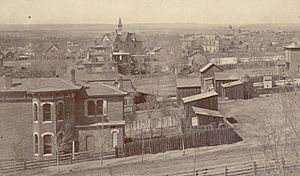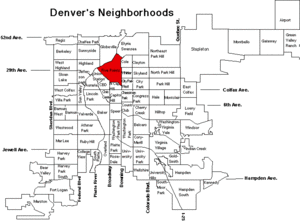Five Points, Denver facts for kids
Quick facts for kids
Five Points
|
|
|---|---|
|
Neighborhood
|
|

Light rail station at Five Points Plaza on Welton Street
|
|
| Country | United States of America |
| State | Colorado |
| City | Denver |
| Area | |
| • Total | 1.5 sq mi (4 km2) |
| Elevation | 5,226 ft (1,593 m) |
| Population
(2020)
|
|
| • Total | 17,520 |
| • Density | 11,680/sq mi (4,510/km2) |
| ZIP Codes |
80205, 80216
|
Five Points is a historic neighborhood in Denver, Colorado. It is one of Denver's oldest areas. Today, it is growing quickly with new buildings and more people moving in. A big part of this growth is happening in the River North Arts District, also called "RiNo." While many locals see RiNo as its own place, it's officially part of the Five Points neighborhood.
Contents
Where is Five Points Located?
Five Points is on the northeast side of Downtown Denver. A small part of it goes around Coors Field. This area is where the straight streets of downtown meet the older, angled streets of Denver's first suburbs. The name "Five Points" comes from where four streets meet: 26th Avenue, 27th Street, Washington Street, and Welton Street. This spot was once a streetcar stop, and "Five Points" was its short name.
A Look Back at Five Points History
Five Points became very important from the 1860s to the 1950s. It was once home to many important people in Denver, like mayors and governors. It also had many middle-class workers. Several smaller areas, like RiNo and Curtis Park, are part of the larger Five Points neighborhood.
The "Harlem of the West"
Five Points was known as the "Harlem of the West." This is because it became a main home for African American people in Denver. At the time, unfair laws in other neighborhoods stopped black people from buying homes there.
From the 1920s to the 1950s, the community was very lively. Welton Street was full of businesses like butcher shops, real estate offices, drug stores, and restaurants. It also had over fifty bars and clubs. Famous jazz musicians like Billie Holiday, Duke Ellington, Miles Davis, and Nat King Cole played there.
Many black performers were not allowed to stay in other Denver hotels. They stayed and performed at the Rossonian Hotel, built in 1912. This made the Rossonian a very famous music spot.
Challenges and Changes
From the late 1950s to the late 1990s, the Five Points community faced tough times. Many buildings were left empty, and local businesses struggled. It was hard to bring new investments into the area. The neighborhood needed new ideas and leaders to help it grow again.
Five Points has always had a mix of people with different incomes. You could find large mansions next to smaller row homes. In the late 1800s, many wealthy residents moved to the popular Capitol Hill neighborhood.
Five Points was also home to a large Jewish community. The former Temple Emanuel synagogue, built in 1920, is still there. After World War II, many Japanese-Americans also lived in Five Points. The Agape Church was once a Japanese Methodist church.
Who Lives in Five Points?
| Historical population | ||
|---|---|---|
| Year | Pop. | ±% |
| 2010 | 12,712 | — |
| 2020 | 17,520 | +37.8% |
In the past, when segregation was common, the area around Welton Street had mostly African American residents. However, over the years, the population has changed. According to the 2020 Census, the majority of people living there are white (77%). There is also a large Latino population (19%) and a black population (14%).
In 2002, Five Points was named a cultural historic district. This was done to honor its important role in African American history in Denver.
Economy and Businesses
In 2002, the Denver Housing Authority bought an old horse barn in the Curtis Park area, near Five Points. In 2012, this building was updated to become office spaces for small businesses. It is now open and helping new businesses grow.
Efforts to bring more businesses to Welton Street began in 2009. The historic Rossonian Hotel, originally called The Baxter, is also being renovated. This hotel was once managed by A. H. W. Ross, who also owned a baseball team called the White Elephants.
Arts and Culture in Five Points
Five Points is a lively center for arts and culture, especially known for its music and festivals.
Juneteenth Celebration
Denver's Juneteenth festival brings thousands of people to Five Points every year. A parade starts at Manual High School and goes down Welton Street. People can buy things from vendors and watch street performers.
Five Points Jazz Festival
The Five Points Jazz Festival happens every May. It is a free, all-day event that celebrates the neighborhood's rich jazz history. Five Points was once called the "Harlem of the West" because so many jazz legends played there. Musicians like Miles Davis and Thelonious Monk performed in its clubs.
The festival started small with just one stage and three bands. Now, it has grown into a huge event with almost 50 bands, 10 stages, and over 100,000 visitors! In 2020, a virtual version of the festival won awards and was nominated for an Emmy.
Getting Around Five Points
Five Points has good public transportation with both buses and light rail. In the early 1990s, Denver's first light rail system connected downtown to Five Points.
Today, the L Line light rail serves the area. A new transit stop was built in 2016 for the A Line. There are plans to extend the L Line to connect with the A Line, adding two new stations.



